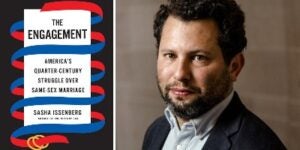Pantheon/Vintage Author Sasha Issenberg Takes on America’s Struggle Over Same-Sex Marriage
With Pride Month 2022 underway, the issue of same-sex marriage continues to be a topic of contentious debate, even though on June 26, 2015, the U.S. Supreme Court ruled that state bans on gay marriage were unconstitutional, making same-sex unions legal across the United States. In Sasha Issenberg’s THE ENGAGEMENT: America’s Quarter-Century Struggle Over Same-Sex Marriage, a New York Times Notable Book in Pantheon hardcover, now out in Vintage paperback, same-sex marriage’s unexpected path from the unimaginable to the inevitable is explored over the course of 900-plus pages.
The richly detailed narrative follows the coast-to-coast conflict through courtrooms and war rooms, bedrooms and boardrooms, to shed light on every aspect of a political and legal controversy that divided many Americans. Following a cast of characters that includes those who sought their own right to wed, those who fought to protect the traditional definition of marriage, and those who changed their minds about it.
In this Behind the Pages Igloo interview, Mr. Issenberg discusses why he chose to delve deeply into the issue of same-sex marriage, what was involved in the research, writing and editing process, and points he hopes will resonate with readers of THE ENGAGEMENT.
What inspired you to take on the important issue of same-sex marriage in book form?I was first drawn to the topic in 2011, a period in which the political momentum around same-sex marriage visibly shifted. People had begun to speak of this as the era’s most successful civil-rights movement, and I was struck that I had no idea when it emerged as a cause, where it came from, and how it became the dominant culture-war conflict of my lifetime. I thought back to the big books about the struggle for racial equality — especially those by Tony Lukas, Dave Garrow, and Taylor Branch — and how the authors used a journalistic toolbox to document the defining social change of their generation, and believed I could aspire to do something similar for mine.
How would you describe the research, writing and editing process that ultimately resulted in THE ENGAGEMENT?When I sold the proposal in June 2012, I thought I would be writing the story of how the country had begun to reach political consensus on this fractious issue, but that when my manuscript was due three years later a national resolution of the legal conflict would still be far off. I had to revisit that assumption within months of beginning work, as the U.S. Supreme Court agreed to hear two cases related to same-sex marriage. After the court in 2013 struck down the Defense of Marriage Act, it started to become clear that instead of trying to rush a book out while the news was unfolding so quickly there was a good chance it could settle on my watch if I hung back instead. In June 2015, the Supreme Court delivered the book’s ending by ruling that same-sex couples had the right to marry nationwide. (Few things do a better job of putting you in your place than watching the Supreme Court work more quickly than you do.) Ultimately, I did not complete my manuscript until early 2018, but that gave me the opportunity to cover the birth, life and death of the gay-marriage debate in a single volume.
What are the most important points that you hope will resonate with readers of THE ENGAGEMENT?When a social movement ends at the Supreme Court, with a landmark decision that extends rights to a category of people who had been denied it, we tend to think that because the outcome was just it must have been inevitable. I hope THE ENGAGEMENT shows that no part of the road to the Obergefell v. Hodges decision was inevitable: it certainly wasn’t inevitable that the matter would come to the Supreme Court when it did, or that the court would be primed to rule as it did. (Had the question of whether states were free to ban same-sex unions reached the court just a few years later, of course, it is easy to imagine a very different outcome.)
But it was also not inevitable that this would become the major LGBT-rights breakthrough of the era, or even a political issue or legal objective altogether. When my book opens, in 1990, there is not a single gay-rights group in the country that has endorsed same-sex marriage, no legislature or court is considering it, and there’s barely a politician in the country who has ever been asked his or her view. History changed because of local and highly personal dynamics: a petty rivalry within a Honolulu pride-planning committee that sprawled out of control and, in barely five years, put the question of whether the federal government should recognize same-sex unions before Congress and the president. Within two decades, the Supreme Court was ruling that the right was guaranteed by the Constitution — much faster than the movements to win women’s suffrage or end Jim Crow. That success was the result of a series of individual choices, tactical and strategic decisions, some far-sighted and some that triggered fateful unintended consequences, along with freakish luck and serendipity at key moments.
I hope readers who may be dispirited by what seems like our very hardened national politics will find some encouragement in that story of how quickly something can go from unimaginable to appearing inevitable. The debates we are having today do not have to control the policy choices before us tomorrow. There’s a reason basically everyone in politics, social justice and consumer marketing wants to apply lessons from the marriage-equality campaigns, and THE ENGAGEMENT is filled with them — straightforward, practical insights for anyone who wants to understand how change happens and what is necessary to accelerate it.

